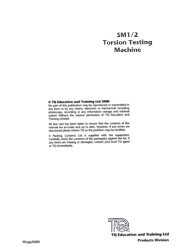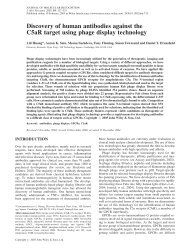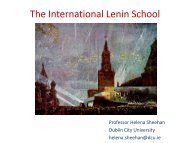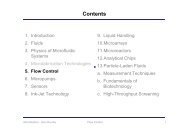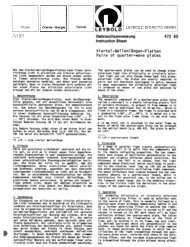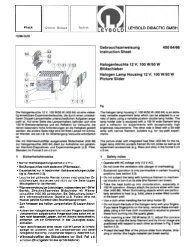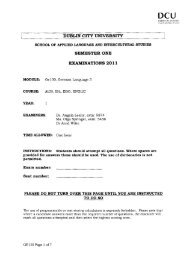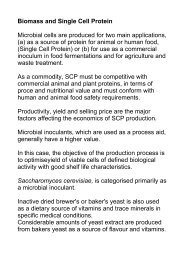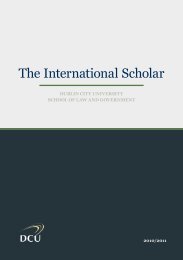Penicillin Production - DCU
Penicillin Production - DCU
Penicillin Production - DCU
You also want an ePaper? Increase the reach of your titles
YUMPU automatically turns print PDFs into web optimized ePapers that Google loves.
<strong>Penicillin</strong> <strong>Production</strong><br />
Tom O’Hare & Lynne White<br />
Abstract<br />
The discovery of penicillin and its medicinal uses was arguably the most important<br />
scientific discovery of the 20 th century. From the observation of an accidental<br />
inoculation to the application of knowledge and technology, the production of<br />
penicillin is a process that has changed dramatically since its beginnings in the late<br />
1930’s and early 1940’s. As new ways were found to ensure that more penicillin was<br />
being produced and that the purification process was as effective as possible, the<br />
production could increase, allowing the use of penicillin in times of war to save the<br />
lives of soldiers who otherwise would have died due to infection of their wounds.<br />
Since then, the development of large scale production has allowed penicillin to be<br />
used whenever needed to kill off bacteria and prevent serious infection, however, this<br />
has also been its downfall. The ability of some bacteria to now produce penicillinase<br />
to break down and render penicillin completely useless has come about due to the<br />
wide scale use of the drug and has therefore limited the effectiveness of penicillin as a<br />
clinical treatment. In order to combat this, scientists have turned to semi-synthetic<br />
derivatives of penicillin in the hope that these will have the properties necessary to<br />
beat the resistance problem.<br />
<strong>Penicillin</strong> and its history<br />
<strong>Penicillin</strong> was the first naturally occurring antibiotic discovered (Prontosil, the first<br />
chemical used to cure certain infectious diseases, had been discovered in 1933 but had<br />
serious side effects). There are now more than 60 antibiotics, which are substances<br />
that are produced by microbes and that fight bacteria, fungi and other microbes<br />
harmful to humans - the word means against (anti) life (bio). <strong>Penicillin</strong> is obtained in<br />
a number of forms from Penicillium moulds.<br />
<strong>Penicillin</strong>: C 16 H 18 N 2 O 5 S<br />
1
As shown in the above diagram, penicillin is not a single compound but a group of<br />
closely related compounds, all with the same basic ring-like structure (a β-lactam)<br />
derived from two amino acids (valine and cysteine) via a tripeptide intermediate. The<br />
third amino acid of this tripeptide is replaced by an acyl group (R in the diagram<br />
below) and the nature of this acyl group produces specific properties on different<br />
types of penicillin.<br />
Bacteria reproduce by dividing to produce two new cells. They enlarge to about twice<br />
their size before the DNA chromosome is copied. The two new chromosomes move<br />
apart and a cell wall forms between them. But if penicillin is present, the new cell<br />
wall won't be able to form. It doesn't harm old bacterial cell walls, but it stops new<br />
ones forming. This means the bacteria can't reproduce, so the disease can't spread.<br />
<strong>Penicillin</strong> acts by blocking the activity of the enzyme transpeptidase, which cross<br />
connects long polymers of sugars that form the bacterial cell wall. The β-lactam ring<br />
on penicillin (see structure) irreversibly blocks the activity of the enzyme by<br />
covalently bonding with the functional end of the enzyme. As a result, newly-formed<br />
cell walls will be structurally weak in some areas, causing water to rush in and rupture<br />
the cell.<br />
There are two different categories of penicillin. Biosynthetic penicillin is natural<br />
penicillin that is harvested from the mould itself through fermentation. The other form<br />
of penicillin is known as semi-synthetic. There are all kinds of what are called semisynthetic<br />
derivatives of penicillin - like Ampicillin, <strong>Penicillin</strong> V, Carbenicillin,<br />
Oxacillin, Methicillin, etc. These compounds consist of the basic <strong>Penicillin</strong> structure,<br />
but have been purposefully modified chemically by removing the acyl group to leave<br />
6-aminopenicillanic acid and then adding acyl groups that produce new properties.<br />
These modern semi-synthetic penicillins have various specific properties such as<br />
resistance to stomach acids so that they can be taken orally, a degree of resistance to<br />
penicillinase (or β-lactamase) (a penicillin-destroying enzyme produced by some<br />
bacteria) and an extended range of activity against some Gram-negative bacteria.<br />
<strong>Penicillin</strong> G (or benzylpenicillin) is the most widely used form and the same one we<br />
get in a shot (hypodermic) form.<br />
2
<strong>Penicillin</strong> G<br />
<strong>Penicillin</strong> G is not stable in the presence of acid (it is therefore said to be acid-labile).<br />
Since our stomach has a lot of hydrochloric acid in it (the pH can be around 2.0), if<br />
we were to ingest penicillin G, the compound would be destroyed in our stomach<br />
before it could be absorbed into the bloodstream, and would therefore not be any good<br />
to us as a treatment for infection somewhere in our body. It is for this reason that<br />
penicillin G must be taken by intramuscular injection - to get the compound in our<br />
bloodstream, which is not acidic at all. Many of the semi-synthetic penicillins can be<br />
taken orally.<br />
The history of penicillin is a fascinating reminder of how the most freak and<br />
seemingly random of occurrences can lead to very significant scientific discoveries.<br />
Also seeing as how the discovery of penicillin is arguably man’s most important<br />
medical (if scientific) advance to date, some discussion of its origins are necessary.<br />
This history clearly displays that discovery in itself is not enough, there must also be a<br />
drive (in this case the huge numbers of soldiers dying from secondary infections in the<br />
second world war) to utilise this new discovery to its fullest.<br />
In 1928, while working in St. Mary’s Hospital in London, bacteriologist Alexander<br />
Fleming was conducting research on the flu. He had been searching for antibacterial<br />
agents, influenced by his wartime experience. He had witnessed the deaths of many<br />
soldiers that died, not from the wounds they received during combat, but from<br />
secondary infections of those wounds. While he was on holidays, a bit of blue-green<br />
mould had fallen into a discarded culture plate containing Staphylococcus aureus,<br />
forming a clear patch in the surrounding area. From this he could conclude that the<br />
mould was producing an antibiotic substance. He named the antibiotic penicillin, after<br />
the Penicillium notatum mould that produced it and 1929, he published the results of<br />
his investigations, noting that his discovery might have therapeutic value if it could be<br />
3
produced in quantity. Unfortunately it couldn’t, and it would be 10 years before<br />
another significant leap forward for penicillin would occur.<br />
In 1938 Dr. Howard W. Florey came across Fleming's paper on penicillin (which<br />
oddly had languished in obscurity). While Fleming’s lab was poorly equipped with no<br />
staff support, Florey's lab was well equipped and staffed with a team of scientists at<br />
Oxford University that included Dr. Ernst B. Chain. It was Chain who began<br />
extracting penicillin into a purified and powerful antibiotic. At first penicillin was<br />
made using old dairy equipment and after a great deal of effort, enough was extracted<br />
for experimentation to begin. Eight white mice were inoculated with deadly<br />
Streptococcus germs, followed by injection of penicillin in half the mice. All of the<br />
untreated mice died the next day while the treated mice all recovered. Now it was<br />
time for the first human test.<br />
Albert Alexander, a 48-year-old London policeman had developed septicaemia as a<br />
result of a small cut on his face. When treated with penicillin Alexander began to<br />
recover within the day. However Florey's team didn't have enough of the drug to see<br />
the patient through to a full recovery and he later re-lapsed and died. However by<br />
1941, it was acknowledged that penicillin was indeed a worthwhile drug and could<br />
save thousands of lives. In the same year Florey travelled to the United States (which<br />
at the time was still neutral) to continue his work with penicillin. Because the United<br />
States intended to enter into World War II in another few months the penicillin<br />
project, which became declared a war project, was given top priority (and funding).<br />
Florey and his team were able to use beer-brewing technology to produce the huge<br />
amounts of the mouldy liquor needed for penicillin production. This underwent a slow<br />
purification process to produce the large amounts of clinically usable penicillin that<br />
became available for military use in early 1940's.<br />
In Peoria, Illinois a blue-green mould was found growing on a mouldy cantaloupe in a<br />
market. This mould was identified as Penicillium chrysogenum and produced<br />
approximately 200 times as much penicillin than what Florey’s team were working<br />
with (Penicillium notatum). Scientists began to try to increase the amount of<br />
penicillin produced by P. chrysogenum, by irradiating it with X-rays and UV rays in<br />
order to induce mutations of this species. They succeeded and developed a mutant that<br />
produced 1000 times the amount of penicillin than Fleming's original culture. At the<br />
same time scientists began to grow the mould in the first deep tank fermenters.<br />
4
By late 1943, mass production of the drug had commenced and by the end of the war,<br />
many companies were manufacturing the drug, including the Merck, Squibb and<br />
Pfizer. In 1945 Fleming was awarded the Nobel Prize in Physiology and Medicine<br />
along with Florey and Chain.<br />
In the coming years, strains and techniques were improved upon and <strong>Penicillin</strong> saved<br />
tens of thousands of lives. However, it all began with a bit of blue-green mould falling<br />
onto a discarded culture plate.<br />
Fermenters<br />
An important part of any fermentation process (of which penicillin is an example) is<br />
the type and configuration of fermenter being used for the fermentation. Generally,<br />
the purpose of a fermenter is to provide a contained, controlled, homogenous<br />
environment in which the fermentation can proceed in a manner that is both safe and<br />
practical and which optimises the particular objectives of the fermentation.<br />
Within these parameters, there is a huge range of variability and flexibility. Flexibility<br />
is frequently a major objective in a lab. Other primary factors include cost, reliability<br />
and safety. It should be noted however that this flexibility tends to decrease with<br />
scale. As reactors become larger and larger there is less and less room for error.<br />
When a reactor is being designed for a specific purpose there are a number of<br />
important parameters that will greatly affect the reactors process performance.<br />
1. Reactor Size: How large does the reactor need to be in order to achieve<br />
optimum rates of production?<br />
2. Reactor Configuration: How will the reactor be configured? For example<br />
should impellers be used to exert mechanical agitation (stirred tank) or will an<br />
air-jet system be used for mixing (bubble column)?<br />
3. Mode of operation: How will substrate be added? Will it be batch fed or<br />
continuously fed?<br />
4. Conditions inside the reactor: What temperature and pH should the reactor be<br />
maintained at? How will contamination be avoided? And how will these<br />
conditions be controlled?<br />
Regardless of how the above parameters are approached, there are still are number of<br />
common desired features that are requirements (both functional and economic) for a<br />
good working reactor. Some of the most common are summarized below:<br />
Functional:<br />
• High gas/liquid mass transfer.<br />
5
• Reasonable heat-transfer.<br />
• Prevention of aggregation without damaging microorganisms.<br />
• Good bulk-flow and mixing to prevent the creation of dead zones in the<br />
reactor.<br />
• Good nutrient transfer.<br />
Economic:<br />
• Easy to operate aseptically.<br />
• Reasonably flexible regarding process requirements.<br />
• Low power consumption.<br />
• Stable under fluctuating conditions.<br />
• Cheap, robust, simple and well understood for scale-up.<br />
Below is an example of a typical reactor configuration:<br />
However, before we examine the above design, we need to take a step backwards to<br />
define some of the above terms.<br />
Mass Transfer is seen when there is mixing between two components of varying<br />
concentrations. A good example is a small amount of dye being dropped into a bucket<br />
of water. Mass Transfer processes are responsible for the movement of the dye<br />
through the water until equilibrium is reached. 1 This is very important when we are<br />
attempting to grow aerobic microbes in media. When the oxygen is bubbled through<br />
the fermenter tank, there will be high concentrations of oxygen near the bubbles but<br />
low concentration everywhere else in the tank. Since oxygen concentration is such a<br />
1 Bioprocess Engineering Principles, Pauline M. Doran.<br />
6
vital component of aerobic metabolism, it is essential that there is good transfer of<br />
oxygen across the gas/liquid interface. The Sparger delivers this oxygen. One problem<br />
with gas/liquid interfaces is the formation of foam. The impeller that serves to break<br />
up the foam generally relieves this.<br />
Heat Transfer is important because metabolism as a process tends to give off heat, as<br />
does the mechanical mixing by the impellers. If the reactor needs to be operated at a<br />
constant temperature of range of temperatures, then it is critical that there is some<br />
kind of system to cool the reactor. This is normally achieved through a combination<br />
of a cooling jacket and cool water being passed around the tank.<br />
Bulk Flow and Mixing are achieved by the impellers. Most reactors use the Rushton<br />
Flat-bladed disc turbine seen in the diagram. Fluid flow in a reactor can be described<br />
as Newtonian or non-Newtonian. Newtonian fluids show constant viscosity and linear<br />
shear rate against shear stress. However many fluids are non-Newtonian and are<br />
described as Bingham or Pseudoplastic.<br />
Batch, Fed-Batch and Continuous Culture are terms used to describe how nutrients<br />
and substrate will be delivered to a culture in a reactor. Batch simply means that a<br />
fixed amount of substrate is added at the beginning of the process. Fed Batch means<br />
that substrate is added in small increments at various times in the fermentation.<br />
Continuous means that substrate is constantly added to the reactor while an equal<br />
amount of fermented medium is removed.<br />
Steam is used to keep the reactor running aseptically. This is achieved because the<br />
reactor is designed as a pressure vessel and steam is sent through at a minimum<br />
temperature/pressure of 121 0 C/15 psi for 15-30min.<br />
So much for our discussion of basic reactor design. What follows is a brief description<br />
of the specific fermentation conditions necessary for the production of penicillin.<br />
Special fermenter Conditions for the production of <strong>Penicillin</strong><br />
Aside from what is described above, there are a few specific characteristics of<br />
penicillin that must be considered when attempting fermentation:<br />
• Most penicillins form filamentous broths that are pseudoplastic (non-<br />
Newtonian) in nature. This means they can be difficult to mix due to their high<br />
(and not constant) viscosity. Also the increasing viscosity of the broth can<br />
hinder oxygen transfer. Which leads to the next point.<br />
• <strong>Penicillin</strong> is an aerobic organism; therefore the rate of oxygen supply is critical<br />
to the fermentation. Thus, the reactor must have an efficient oxygen supply<br />
system.<br />
7
• The optimum pH for penicillin growth is 6.5. Thus the reactor must maintain<br />
pH efficiently (this is frequently done by addition of NaOH).<br />
• Strain Stability problems do exist and careful strain maintenance is required.<br />
• Biomass doubling is about 6h.<br />
Media Considerations<br />
When performing any kind of fermentation, the selection of media is of critical<br />
importance to the overall performance of the fermentation. The aim of the media is to<br />
provide all the elements required for the synthesis of cell materials and the formation<br />
of the desired product. At the same time, the media must provide a favourable<br />
environment for the culture in question (an example of this would be control of pH by<br />
addition of calcium carbonate or inorganic phosphates). As well as this it must remain<br />
cost effective.<br />
Typically, all microorganisms require Carbon, Hydrogen, Oxygen, Sulphur and<br />
Nitrogen for cell growth and cell maintenance. In many cases, microorganisms<br />
require small amounts of trace elements such as Cu, Mn and Co (this will frequently<br />
depend on the water source as most water sources contain small amounts of the<br />
elements) or growth factors such as vitamins or amino acids as well. Also, certain<br />
organisms such as Penicillium chrysogenum that produce antibiotics, enzymes or<br />
other secondary metabolites frequently require precursors like purine/pyrimidine<br />
bases or organic acids to produce said metabolites.<br />
At this stage, it is necessary to give a brief discussion of the differences between<br />
primary and secondary metabolism. Primary metabolism is the metabolism of energy<br />
production for the cell and for its own biosynthesis. Typically, in aerobic organisms<br />
(such as Penicillium chrysogenum) it involves the conversion of sugars such as<br />
glucose to pyruvic acid 2 and the production of energy via the TCA cycle.<br />
Secondary metabolism regards the production of metabolites that are not used in<br />
energy production for example penicillin from Penicillium chrysogenum. In this case<br />
the metabolite is being utilized as a defence mechanism against other microorganisms<br />
in the environment. In essence Penicillium chrysogenum can “kill off the<br />
competition” to allow itself to propagate efficiently.<br />
The last sentence is particularly important. Here it should be noted that these<br />
secondary metabolites are only produced in times of stress when resources are low<br />
and the organism much produce these compounds to kill off its competitors to allow it<br />
2 As an aside in anaerobic organisms this pyruvic acid can be converted into other commercially<br />
important compounds such as alcohol and lactic acid.<br />
8
to survive. It is these conditions that we wish to duplicate in order to achieve the<br />
maximum amount of product from our fermentation.<br />
This leads us onto the next point. Generally, this kind of fermentation is done in<br />
stages. In the first stage, primary metabolism will be emphasised. Media for this stage<br />
will typically be focussed on achieving maximum growth and biomass production. At<br />
this stage, Glucose (Starch) will usually be the primary source of carbohydrate for the<br />
culture. This is because this sugar is the most easily used for energy metabolism and<br />
thus gives the best yields in terms of growth. At this stage a substrate is frequently<br />
added that will give a readily usable source of Nitrogen as well such as corn steep<br />
liquor. Both these substrates allow maximal growth of the culture at the expense of<br />
product (antibiotic) formation. This is because growth and antibiotic production are<br />
mutually interrelated and inversely proportionate. Readily available carbon and<br />
nitrogen sources tend to inhibit antibiotic production (this is known as Catabolite<br />
Repression, where a secondary metabolite is inhibited by the presence of a more<br />
readily usable substrate).<br />
In the next stage, the production stage, we wish to do almost the exact opposite as the<br />
first stage. Once the desired biomass has been achieved, we wish to “starve” the<br />
culture and induce the kind of stress conditions that trigger the production of the<br />
antibiotic. Limiting the amount of carbon and nitrogen available to the culture<br />
typically does this. Hence, the amount of carbon source that is added must be<br />
carefully controlled. In order to do this, lactose is frequently used as carbohydrate<br />
source in this part of the fermentation. It is also very important that the nitrogen<br />
source is carefully controlled, as excess nitrogen will greatly inhibit antibiotic<br />
production.<br />
The solution to this is to use the fed-batch method to feed the culture. As stated above,<br />
this allows us to add the substrate to the reactor in small increments and to even<br />
change the substrate if we so desire. This is the best way to change from one<br />
production stage to another.<br />
There are also several other considerations regarding this stage of production. First of<br />
all, as mentioned above, at this stage there is frequently a need for the addition of<br />
precursor molecules (e.g. purine/pyrimidine) into the medium. Other additives can<br />
include the addition of inorganic phosphates to alter pH and chemical anti-foaming<br />
agents to prevent the development of foam. These also must be considered with the<br />
media.<br />
9
Process considerations and Scale-up<br />
This section deals with the various steps in a fermentation process, from the initial<br />
activation of a preserved culture right up to the full-scale industrial production of the<br />
antibiotic of interest. As can be imagined, there are numerous factors that must<br />
considered, each playing a different role at different stages in the fermentation.<br />
Almost all fermentations begin with the preserved culture. This is a kind of stock of<br />
established culture from which other cultures are grown. Frequently, this will be a<br />
stock that has been modified over time (genetically or not) to give the best possible<br />
yield of product and as such is generally very valuable. For this reason, it is often<br />
desirable to use as little of this stock as possible to initiate the fermentation process.<br />
Often the best way to preserve these cultures is in the form of inactive spores. This is<br />
because spores are very resistant structures that can survive heat, desiccation, low pH<br />
and mechanical forces that would typically kill a normal vegetative cell. To increase<br />
their longevity, these spores are often kept in a cyropreservative fluid (e.g.<br />
Microbead® system) and frozen. In this way the cells can be preserved for many<br />
years.<br />
To begin the fermentation process, a number of these spores will be introduced into a<br />
small (normally 250-500ml) conical flask where it will be incubated for several days.<br />
At this stage, explosive growth is the most desired parameter and as such the medium<br />
in the flask will contain high amounts of easily utilisable carbon and nitrogen sources,<br />
such as starch and corn-steep liquor. At this stage, the spores will begin to revive and<br />
form vegetative cells. Temperature is normally maintained at 23-28 0 C and pH at ~6.5,<br />
although there may be some changes made to facilitate optimum growth. The flask<br />
will often have baffles in it and be on a shaking apparatus to improve oxygen<br />
diffusion in the flask.<br />
Once the overall conditions for growth have been established and there is a viable<br />
vegetative culture active inside the flask, it will be transferred to a 1 or 2 litre benchtop<br />
reactor. This reactor will be fitted with a number of instruments to allow the<br />
culture to be better observed than it was in the shake flask. Typical parameters<br />
observed include pH, temperature, stirrer speed and dissolved oxygen concentration.<br />
This allows “tweaking” of the process to occur and difficulties to be examined. For<br />
example, there may not be enough oxygen getting to the culture and hence it will be<br />
oxygen starved. Another example would be high shear-rate leading to cell damage. To<br />
resolve these problems, modifications will be made to the process and/or the reactor.<br />
The majority of optimisation of the process occurs here in the bench-top reactor as<br />
well as gathering of important information about the activity of the cells. At this point,<br />
10
the cells should be showing filamentous morphology, as this is preferred for penicillin<br />
production. As before, cell growth is priority at this stage. This reactor is often viewed<br />
as a type of prototype for the larger fermentations that follow.<br />
Once this has been successful the process is scaled-up again to a pilot-scale<br />
bioreactor. This reactor will be similar in design to the bench-top reactor except it<br />
will have a size of about 100-1000 litres. The aim here is to examine the effect of<br />
scale-up on the culture. At this stage, hopefully growth will continue as before,<br />
however, there are often sudden changes or loss in performance. This can be due to<br />
changes in the morphology of the culture (remember Penicillium chrysogenum is a<br />
filamentous fungi and hence pseudoplastic) that may or may not be correctable.<br />
If the pilot-plant stage is successful then work can begin on an industrial scale<br />
operation. This is now very much an engineering problem. The reactor must be<br />
capable of running aseptically and the design must reflect safety and contamination<br />
requirements. At this stage the medium being added to the reactor will change. Now<br />
we wish to emphasis penicillin production over growth while maintaining a constant<br />
volume. Carbon and nitrogen will be added sparingly alongside precursor molecules<br />
for penicillin fed-batch style. Another note is that the presence of penicillin in the<br />
reactor is itself inhibitory to the production of penicillin. Therefore, we must have an<br />
efficient method for the removal of this product and to maintain constant volume in<br />
the reactor. Other systems, such as cooling water supply, must also be considered. If<br />
all this goes to plan, we should have fully functioning reactor that is production<br />
penicillin ready for downstream processing 3 . From here it can be refined and<br />
packaged for marketing and distribution to a global market.<br />
Resistance<br />
Alexander Fleming predicted that the use of penicillin would, in time, be of limited<br />
value because bacteria would eventually recombine genetically to resist the effects of<br />
penicillin. (If there are 100,000 bacterial cells capable of causing an infection, and<br />
only one cell in this population can make penicillinase, then treating the infection<br />
with penicillin will allow only this cell to survive - and to therefore reproduce - now -<br />
we can have 100,000 penicillin-resistant disease-causing bacteria!) By as early as<br />
1952, as much as three-fifths of all staph infections were penicillin resistant. Various<br />
steps were taken so as to continue the use of antibiotics. Although the penicillins are<br />
still used clinically, their value has been diminished by the widespread development<br />
3 It should be noted that a full discussion of downstream processing is beyond the scope of this<br />
document.<br />
11
of resistance among target microorganisms and also by some people's allergic reaction<br />
to penicillin (1 in 10 people are allergic to penicillin). The discovery of the naturallyoccuring<br />
penicillinase inhibitor clavulanic acid has dramatically opened the way for<br />
chemically modifying β-lactamase-susceptible agents such as ampicillin and<br />
amoxicillin. This compound irreversibly binds to penicillinase and prevents the<br />
enzyme from working. So, if worried about a particular bacterium being resistant to<br />
penicillin, clavulanic acid can be given along with one of the semi-synthetic<br />
penicillins.<br />
Methicillin-resistant Staphylococcus Aureus (MRSA) is a type of bacteria that is<br />
resistant to certain antibiotics, inclluding methicillin, oxacillin, penicillin and<br />
amoxicillin. Staphylococcus infections, including MRSA, occur most frequently<br />
among persons in hospitals and healthcare facilities who have weakened immune<br />
systems. Staphylococcus aureus is found on many individuals skin and causes no<br />
problems. However if it gets inside the body, it can cause infections such as boils or<br />
pneumonia.<br />
There is no tried and tested method for defeating organisms like MRSA, but as<br />
science advances, new ways of treating such resistant bacteria are being developed<br />
and will hopefully be effective in years to come. The discovery of clavulanic acid is<br />
an important one in the fight against these organisms but bacteria are very adaptable.<br />
The use of antibiotics must be strictly controlled if they are to remain useful as a<br />
defence against infection, and technology must struggle to keep up with the advances<br />
of nature.<br />
References<br />
Biochemistry of Antimicrobial Action; T.J. Franklin and G.A. Snow, Fourth Edition<br />
http://inventors.about.com/library/inventors/blpenicillin.htm<br />
http://helios.bto.ed.ac.uk/bto/microbes/penicill.htm<br />
http://nobelprize.org/medicine/educational/penicillin/readmore.html<br />
http://en.wikipedia.org/wiki/<strong>Penicillin</strong><br />
http://www.link.med.ed.ac.uk/RIDU/Mrsa.htm<br />
Biotechnology and fungal differentiation / edited by J. Meyrath, J. D. Bu'Lock<br />
Bioprocess engineering principles / Pauline M. Doran<br />
Fermentation Biotechnology; principles, processes, products / Owen P. Ward<br />
12






